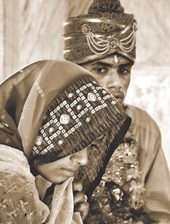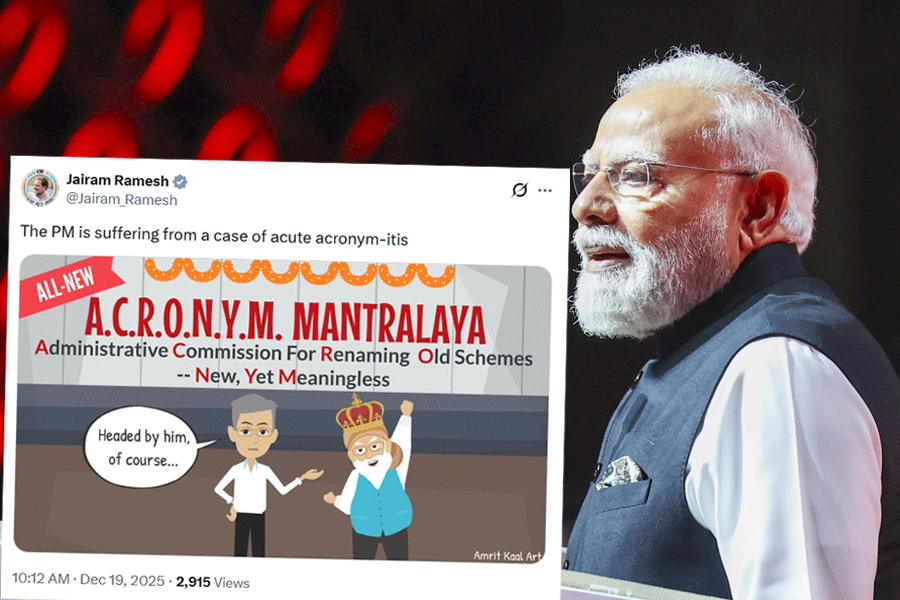 |
On July 16 this year, a 15-year-old girl married to an already married man was tortured and murdered for dowry, not in a remote village but in the heart of Calcutta.
Grassroots worker Shakuntala Verma’s hands were hacked off when she urged members of her community in rural Madhya Pradesh not to solemnise a child marriage.
Incidents such as these are not few and far between. In fact, some alarming statistics collated by the National Family Health Survey in recent times reveal that over 40 percent of marriages in India involve girls below 16 years of age. In states like Bihar, Rajasthan, Uttar Pradesh and Madhya Pradesh, the number of child marriages is as high as 70 per cent.
In the wake of such incidents which seem to hit the headlines at regular intervals, the Child Marriage Restraint Act of 1929 has finally been repealed. In its place, a new Child Marriage Prohibition Act has been passed by Parliament.
The Act received the President’s approval this year and was published for the first time in the Gazette of India in January 2007.
“The new Act has introduced a number of changes but it has also thrown up a plethora of controversies,” says legal expert B.B. Ghosh. Non-governmental organisations such as Prayas, Prakriti and Joint Women’s Programme, which fight for women’s rights, have already sent a joint letter to the President declaring “the new Act is toothless and unable to address issues on the ground”.
“A major shortcoming of the Child Marriage Prohibition Act is that instead of declaring every child marriage void, it places the onus of declaring such a marriage void on the child or her guardians who can file legal proceedings against the marriage,” explains Sunil Kumar Mitra, senior lawyer, Calcutta High Court, and president of Incorporated Law Society, a body of lawyers and solicitors of Calcutta High Court recognised by the West Bengal government. “Considering the social pressures surrounding such marriages, it is highly unlikely that parents will ever move court,” he points out.
The Act states every child marriage shall be void at the option of the contracting party who was a child at the time of marriage (females have to be 18 years and males 21 years to be recognised as adults). The marriage can be annulled by the filing of a petition at the district court or before the child marriage prohibition officer by the child’s guardian or by the contracting party after he or she attains adulthood. Therefore, there’s hardly any independent authority to look into the matter other than those involved themselves.
Many believe that the appointment of child marriage prohibition officers by state governments will not be of much help. This, despite the fact that such officers will have the jurisdiction to look into cases of child marriages in a particular area. They will have the power to prevent such marriages from being solemnised and sensitise the community against the evils of such a practice. They will be able to collect evidence and prosecute those involved in the crime. The officers will be considered public servants and no legal proceedings may be started against them in view of the work they do.
“But what happens in villages and towns where officials can be easily bribed or compelled to overlook child marriages,” asks social activist Nivedita Dasgupta, member of the National Federation of Indian Women. “The government ought to be aware of the problems of implementing such an Act at the grassroots level,” she says indignantly.
True, the Act has no provision for punishing any officer in whose area such marriages are solemnised. “This will merely encourage officials to turn a blind eye to child marriages wherever there is social and community pressure. On the contrary, the Act calls for the punishment of parents, forgetting that many child marriages are performed to escape the debilitating demands of the dowry system,” says Alok Kumar Mitra, lawyer at the Calcutta High Court.
While all offences under this Act have been made cognisable and non-bailable, the punishment does not seem to be too harsh. The Act states that an adult male who marries a child or one who performs, conducts or directs a child marriage will get a maximum jail term of two years or be fined.
“One good thing is that the court has been given power to issue an injunction on such a marriage on receipt of news of a child marriage from the child marriage prohibition officer or from any other source,” stresses advocate Prabir Chowdhury. A judicial, a first class or a metropolitan magistrate has the power to issue the injunction against any person, including the member of a community or organisation, prohibiting such a marriage.
“The Act will also come down heavily on marriages that lead to the trafficking of women, especially in Rajasthan, Uttar Pradesh, Chhattisgarh and even Kerala where trafficking of married girls is rampant,” adds Mitra.
A large number of child marriages end up with girls being sold for trafficking. Marriages being terminated as a result of compulsion and at times culminating in trafficking have been included in the list of void marriages.
“But does this implicitly acknowledge traditional child marriages as valid,” asks Dasgupta. The Act doesn’t speak of child marriages in communities where it’s more of a tradition than compulsion. It is also silent on the registration of child marriages. “Though such marriages are illegal, they should be recorded without issuing certificates as is done in the case of adult marriages, for future reference,” feels Rajesh Ganguly, a Calcutta High Court lawyer, adding, “Since children born out of such marriages will get legitimate status, they should also be issued birth certificates.”
Most activists and victims of child marriages believe that the government needs to provide alternative economic support and livelihood options for children who want to opt out of the abusive environment. “The Act should have introduced protection for the child bride, so that her right to maintenance and her right to a household are not undermined,” says Ketaki Das, a victim of a traditional child marriage. Alas, the Act has no provision for that.











